Study on Filtration Efficiency of Filter Elements for Lubricating Oil Separation
Abstract
1. Introduction
2. Experimental Set-Up and Method
3. Results and Discussion
3.1. Effect of Gas Temperature
3.2. Effect of Aerosol Concentration
3.3. Effect of Flowrate
4. Conclusions
Author Contributions
Funding
Data Availability Statement
Conflicts of Interest
References
- Ding, G.S.; Li, C.; Yang, J.M.; Xu, H.C.; Zheng, Y.L.; Wanyan, Q.Q.; Zhao, Y.J. The status quo and technical development direction of underground gas storages in China. Nat. Gas Ind. 2015, 35, 107–112. (In Chinese) [Google Scholar] [CrossRef]
- Ding, G.S.; Wei, H. Review on 20 years’ UGS construction in China and the prospect. Oil Gas Storage Transp. 2020, 39, 5–31. (In Chinese) [Google Scholar]
- Kampa, D.; Wurster, S.; Buzengeiger, J.; Mayer, J.; Kasper, G. Pressure drop and liquid transport through coalescence filter media used for oil mist filtration. Int. J. Multiph. Flow 2014, 58, 313–324. [Google Scholar] [CrossRef]
- Chang, C.; Ji, Z.L.; Liu, J.L. The effect of a drainage layer on the saturation of coalescing filters in the filtration process. Chem. Eng. Sci. 2017, 160, 354–361. [Google Scholar] [CrossRef]
- Chen, F.; Ji, Z.L.; Qi, Q.Q. Effect of pore size and layers on filtration performance of coalescing filters with different wettabilities. Sep. Purif. Technol. 2018, 201, 71–78. [Google Scholar] [CrossRef]
- Mullins, B.J.; Mead-Hunter, R.; Pitta, R.N.; Kasper, G.; Heikamp, W. Comparative performance of philic and phobic oil-mist filters. AIChE J. 2014, 60, 2976–2984. [Google Scholar] [CrossRef]
- Penner, T.; Mayer, J.; Dittler, A. Oleophilic and oleophobic media combinations -Influence on oil mist filter operating performance. Sep. Purif. Technol. 2021, 261, 118255. [Google Scholar] [CrossRef]
- Song, R.J.; Ji, K.; Chen, Y.E.; Zhang, Y.X.; Tang, M.; Li, H.T.; Chang, C. Experimental on liquid passage saturation and pressure drop of gas-liquid coalescing filter material. Oil Gas Storage Transp. 2023, 42, 670–677. (In Chinese) [Google Scholar]
- Chen, F.; Ji, Z.L.; Qi, Q.Q. Effect of liquid surface tension on the filtration performance of coalescing filters. Sep. Purif. Technol. 2019, 209, 881–891. [Google Scholar] [CrossRef]
- Kolb, H.E.; Mayer, J.; Kasper, G. Flow velocity dependence of the pressure drop of oil mist filters. Sep. Purif. Chem. Eng. Sci. 2017, 166, 107–114. [Google Scholar] [CrossRef]
- Penner, T.; Mayer, J.; Kasper, G.; Dittler, A. Impact of operating conditions on the evolution of droplet penetration in oil mist filters. Sep. Purif. Technol. 2019, 211, 697–703. [Google Scholar] [CrossRef]
- Straube, C.; Meyer, J.; Dittler, A. Investigation of the local oil distribution on oleophilic mist filters applying X-ray micro-computed tomography. Sep. Purif. Technol. 2023, 311, 123279. [Google Scholar] [CrossRef]
- Mead-Hunter, R.; Mullins, B.J.; Becker, T.; Braddock, R.D. Evaluation of the force required to move a coalesced liquid droplet along a fiber. Langmuir 2011, 27, 227–232. [Google Scholar] [CrossRef]
- Mead-Hunter, R.; Bergen, T.; Becker, T.; O’leary, R.A.; Kasper, G.; Mullins, B.J. Sliding/rolling phobic droplets along a fiber: Measurement of interfacial forces. Langmuir 2012, 28, 3483–3488. [Google Scholar] [CrossRef] [PubMed]
- Schwarzwälder, A.; Meyer, J.; Dittler, A. Experimental analysis of droplet coalescence and transport mechanisms on a single vertical fiber. Exp. Fluids 2023, 64, 103. [Google Scholar] [CrossRef]
- Chen, F.; Ji, Z.L.; Yu, W.H.; Dong, W.; Wang, Q.; Wang, D. Influence of nanofiber membrane wettability on gas-liquid filtration performance of sandwiched composite filters. J. Text. Res. 2022, 43, 63–69, 85. (In Chinese) [Google Scholar]
- Chang, C.; Lyu, Q.; Ding, Y.H.; Ji, Z. Investigation of oil mist filtration performance of surface modified coalescence filters with asymmetric wettability. Sep. Purif. Technol. 2024, 331, 125465. [Google Scholar] [CrossRef]
- Chang, C.; Ji, Z.L.; Liu, C.; Zhao, F.T. Permeability of filter elements used for natural gas filtration at high pressure. J. Nat. Gas Sci. Eng. 2016, 34, 419–427. [Google Scholar] [CrossRef]
- Chang, C.; Wang, D.Y.; Wang, Y.W. Performance measurement and analysis of gas coalescence filter element. Oil Gas Storage Transp. 2021, 40, 1161–1166. (In Chinese) [Google Scholar]
- Liu, Z.; Du, H.D.; Hu, X. Experimental investigation of influence of high-pressure condition on filtration performance of natural gas filter element. J. Chem. Ind. Eng. Soc. China 2021, 72, 2669–2679. (In Chinese) [Google Scholar]
- Li, Y.P.; Chen, F.; Sun, Y.; Jia, H.J.; Gan, J.; Yu, W.H.; Jiao, Q.; Ji, Z.L. Performance analysis and optimization of oleophobic coalescing filter element at high gas velocity. Oil Gas Storage Transp. 2023, 42, 817–825, 834. (In Chinese) [Google Scholar]
- Boegnakke, C.; Sonntag, R.E. Fundamentals of Thermodynamics, 8th ed.; Wiley: New York, NY, USA, 2013; p. 758. [Google Scholar]
- Reed, C.M.; Wilson, N. The fundamentals of absorbency of fibers, textile structures and polymers. I. The rate of rise of a liquid in glass-capillaries. J. Phys. D Appl. Phys. 1993, 26, 1378–1381. [Google Scholar] [CrossRef]
- Payet, S.; Boulaud, D.; Madelaine, G.; Renoux, A. Penetration and pressure drop of a HEPA filter during loading with submicron liquid particles. J. Aerosol Sci. 1992, 23, 723–735. [Google Scholar] [CrossRef]
- Frising, T.; Thomas, D.; Bemer, D.; Contal, P. Clogging of fibrous filters by liquid aerosol particles: Experimental and phenomenological modeling study. Chem. Eng. Sci. 2005, 60, 2751–2762. [Google Scholar] [CrossRef]
- Kampa, D.; Wurster, S.; Mayer, J.; Kasper, G. Validation of a new phenomenological “jump-and-channel” model for the wet pressure drop of oil mist filters. Chem. Eng. Sci. 2015, 122, 150–160. [Google Scholar] [CrossRef]
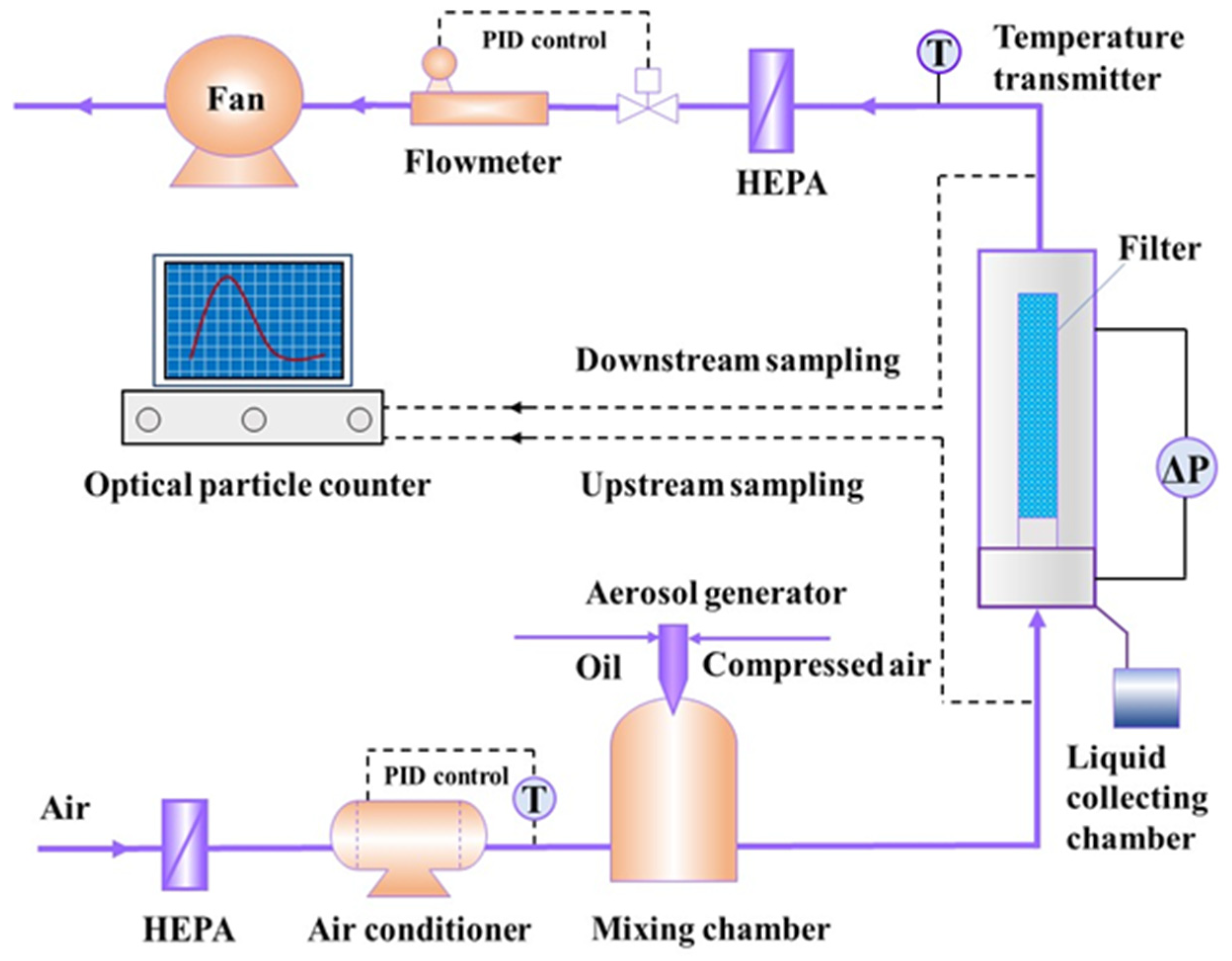
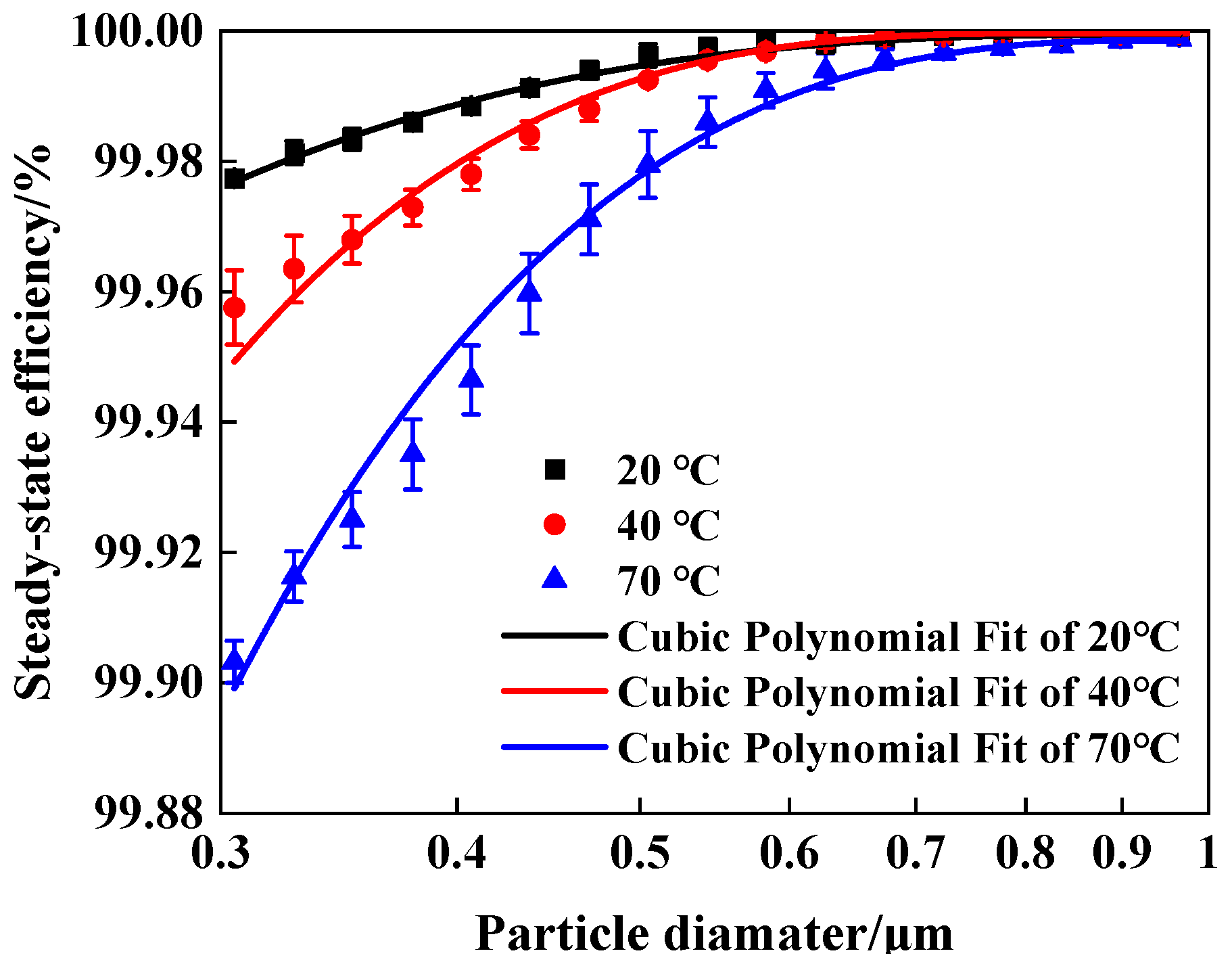

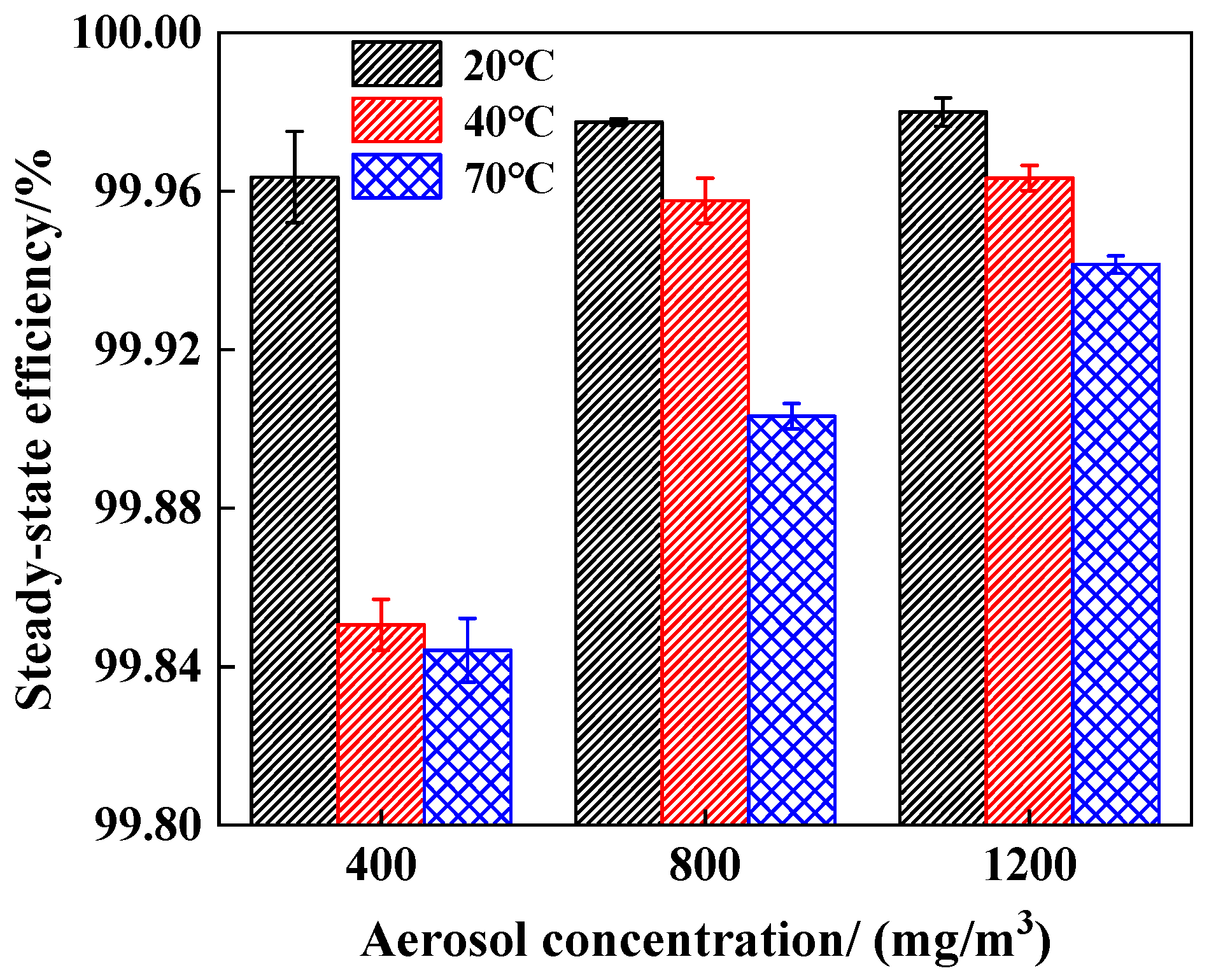

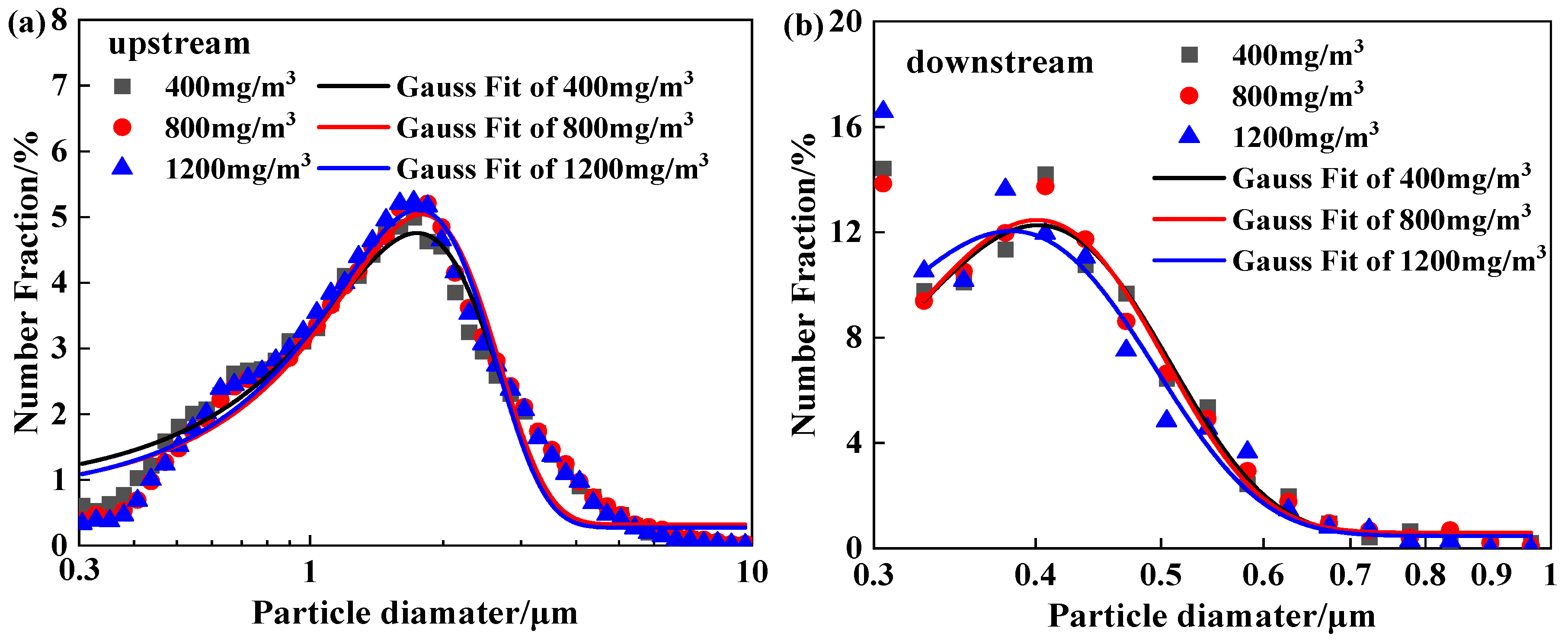
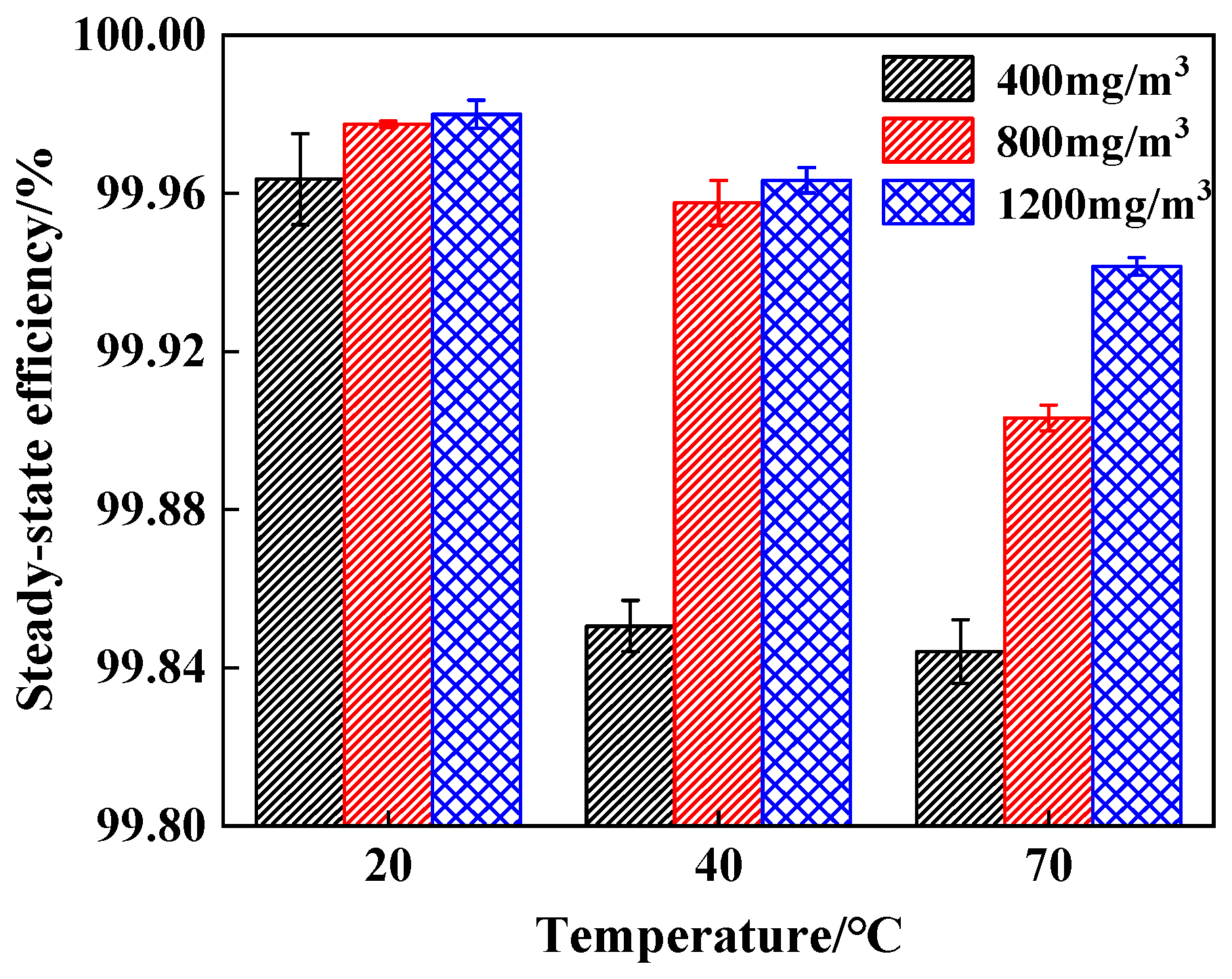
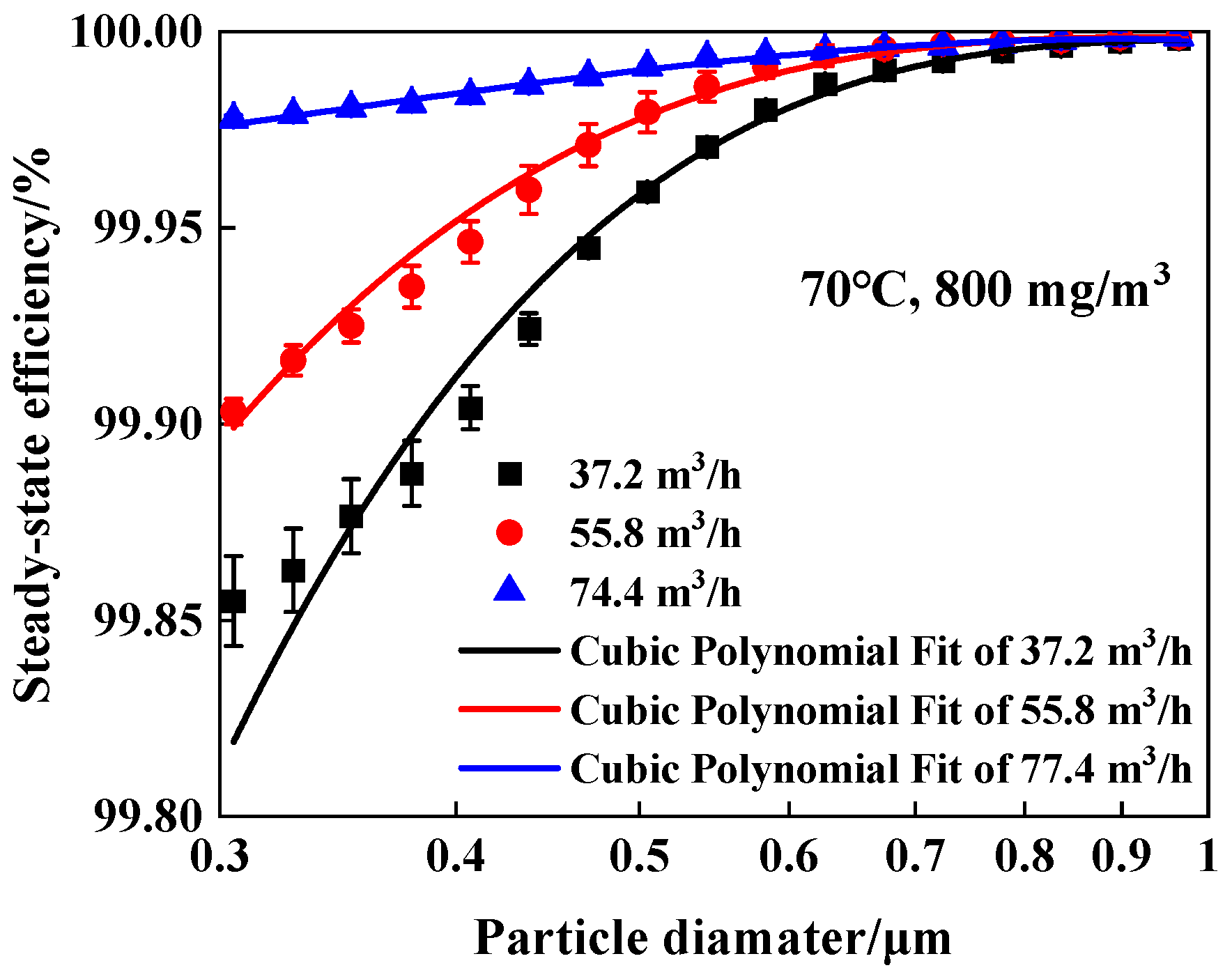
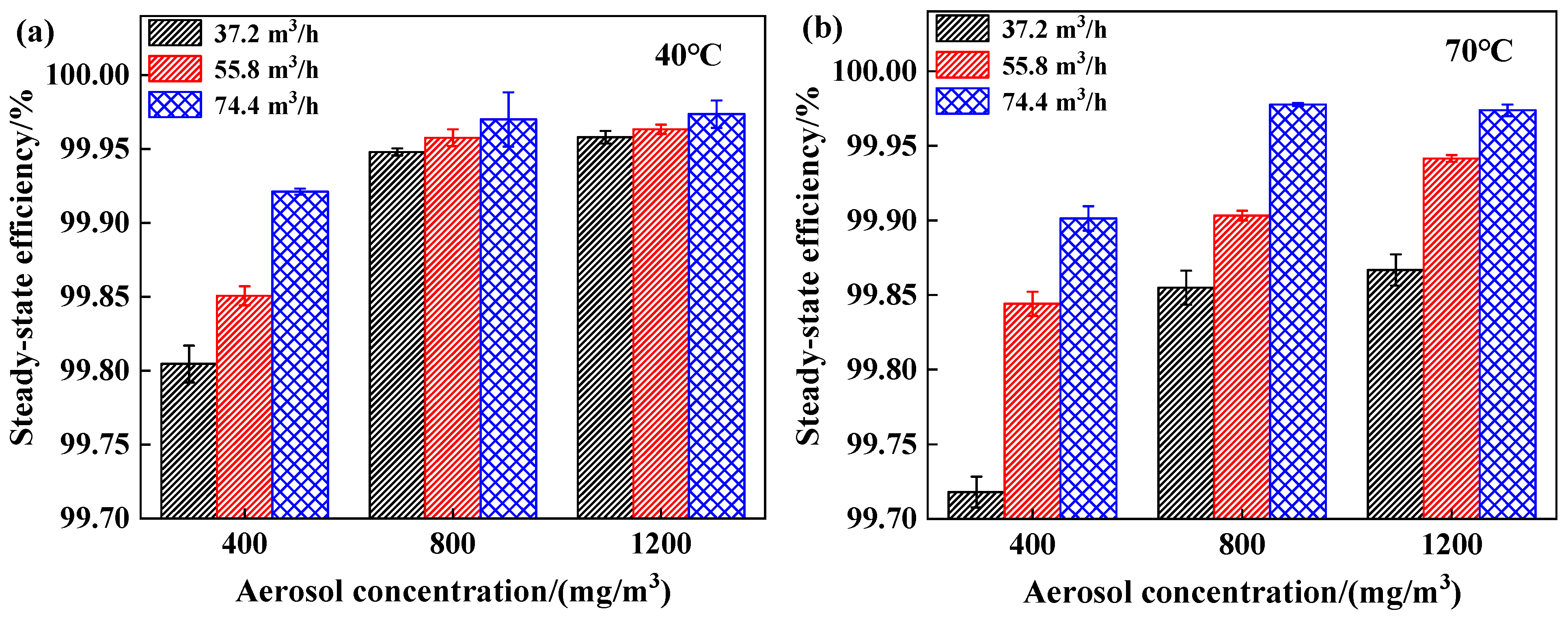
| Material | Thickness (mm) | Packing Density (−) | Fiber Diameter (μm) | Contact Angle (°) |
|---|---|---|---|---|
| Glass fiber | 0.548 ± 0.009 | 0.060 ± 0.001 | 2.87 ± 0.03 | 105.3 ± 1.8 |
| Component | Molar Mass/(g/mol) | Mole Ratio/% | Critical Temperature/K | Critical Pressure/kPa |
|---|---|---|---|---|
| Methane | 16.043 | 93.56 | 190.4 | 4600 |
| Ethane | 30.070 | 1.43 | 305.4 | 4880 |
| Propane | 44.094 | 0.98 | 369.8 | 4250 |
| Isobutane | 58.124 | 0.19 | 408.1 | 3650 |
| n-Butane | 58.124 | 0.39 | 425.2 | 3800 |
| Isopentane | 72.151 | 0.18 | 460.9 | 3330 |
| n-Pentane | 72.151 | 0.33 | 469.7 | 3370 |
| Nitrogen | 28.014 | 0.94 | 126.2 | 3390 |
| Carbon dioxide | 44.010 | 2.00 | 304.1 | 7380 |
Disclaimer/Publisher’s Note: The statements, opinions and data contained in all publications are solely those of the individual author(s) and contributor(s) and not of MDPI and/or the editor(s). MDPI and/or the editor(s) disclaim responsibility for any injury to people or property resulting from any ideas, methods, instructions or products referred to in the content. |
© 2025 by the authors. Licensee MDPI, Basel, Switzerland. This article is an open access article distributed under the terms and conditions of the Creative Commons Attribution (CC BY) license (https://creativecommons.org/licenses/by/4.0/).
Share and Cite
Li, H.; Wang, S.; Liu, M.; Song, R.; Cui, K.; Chang, C. Study on Filtration Efficiency of Filter Elements for Lubricating Oil Separation. Processes 2025, 13, 2067. https://doi.org/10.3390/pr13072067
Li H, Wang S, Liu M, Song R, Cui K, Chang C. Study on Filtration Efficiency of Filter Elements for Lubricating Oil Separation. Processes. 2025; 13(7):2067. https://doi.org/10.3390/pr13072067
Chicago/Turabian StyleLi, Hongjun, Shengping Wang, Mingxin Liu, Rongjun Song, Kailong Cui, and Cheng Chang. 2025. "Study on Filtration Efficiency of Filter Elements for Lubricating Oil Separation" Processes 13, no. 7: 2067. https://doi.org/10.3390/pr13072067
APA StyleLi, H., Wang, S., Liu, M., Song, R., Cui, K., & Chang, C. (2025). Study on Filtration Efficiency of Filter Elements for Lubricating Oil Separation. Processes, 13(7), 2067. https://doi.org/10.3390/pr13072067






